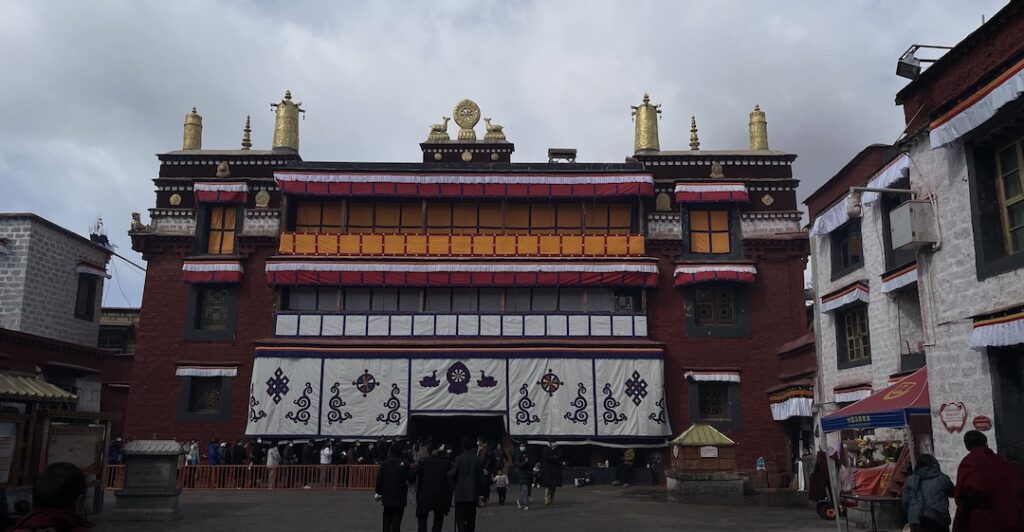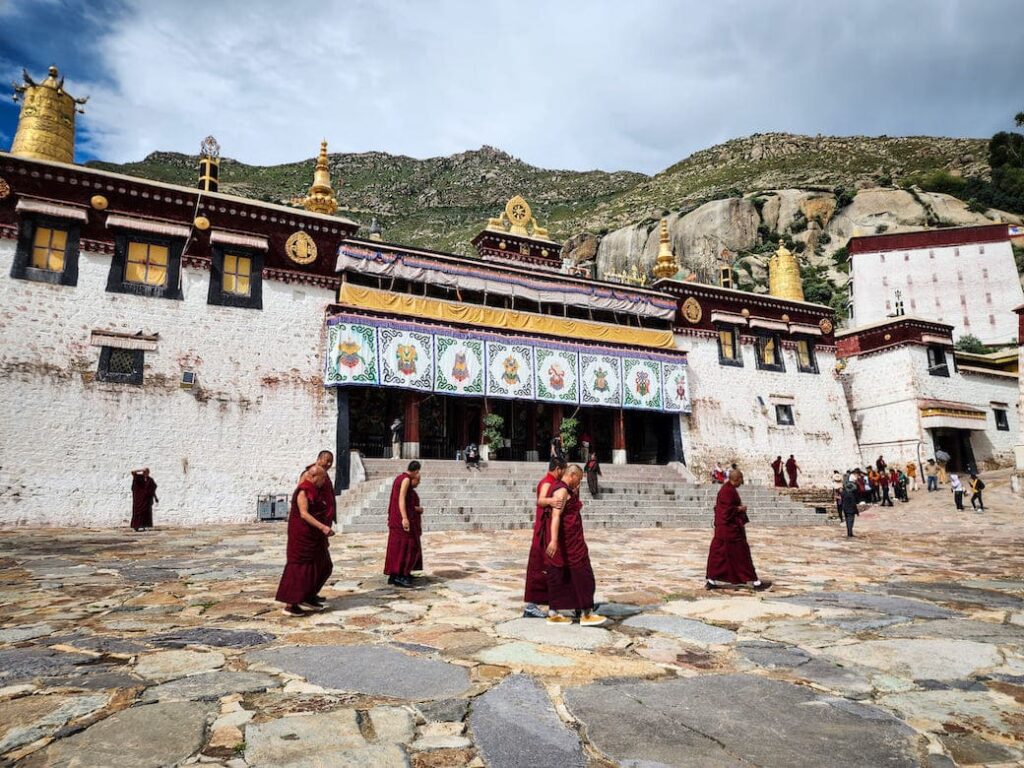Winter in Tibet is a magical time when the land is draped in pristine white snow, and the vibrant spirit of the people comes alive through unique and centuries-old festivals. These celebrations, deeply rooted in Tibetan culture and Buddhist traditions, offer visitors an unforgettable glimpse into the rich heritage of this mystical region.

Losar Festival: Welcoming the Tibetan New Year
The Losar Festival marks the Tibetan New Year, usually celebrated in January or February. This year it’s on 10th February 2024.
Losar, the Tibetan New Year, is a vibrant and deeply significant festival celebrated by the Tibetan people. The word “Losar” itself translates to “New Year” in Tibetan, and the festival marks the beginning of the lunar new year according to the Tibetan calendar. The exact date varies each year, usually falling in either January or February, aligning with the first new moon.
The preparations for Losar commence well before the actual celebration. Families engage in thorough cleaning of their homes as a symbol of bidding farewell to the previous year and welcoming the new one with a fresh start. Special attention is given to the family shrine, where offerings are made, and butter lamps are lit.
One of the distinctive features of Losar is the “Gutor” ceremony, held in the days leading up to the New Year. Gutor involves rituals to dispel any accumulated negativity from the past year. Monasteries perform unique cham dances, masked performances, and rituals aimed at purifying the environment and individuals.
On the eve of Losar, families come together for a festive reunion dinner, sharing traditional Tibetan dishes. Butter tea, momos (dumplings), and various sweet treats are commonly enjoyed during this time. The evening is often filled with laughter, song, and dance as loved ones gather to welcome the approaching year.
The main day of Losar is marked by vibrant and colorful processions through the streets. Participants wear traditional clothing, adorned with intricate jewelry and symbols representing auspiciousness. Monasteries play a central role in the celebrations, with monks leading religious ceremonies and prayers to invoke blessings for the coming year.
The “Lama Losar,” which follows the New Year, is dedicated to honoring spiritual leaders and teachers. Pilgrims visit monasteries to seek blessings, and monks perform rituals to express gratitude for the teachings they have received.

Losar also incorporates unique customs like the creation of intricate sand mandalas, which are meticulously constructed and then ritually dismantled, symbolizing the impermanence of life. Additionally, the raising of prayer flags and the burning of juniper branches are common practices during Losar.
The festival not only holds cultural significance but also has deep religious roots in Tibetan Buddhism. It is a time for reflection, renewal, and strengthening of family and community bonds. As Tibetans around the world come together to celebrate Losar, the festival becomes a powerful expression of their resilience, cultural identity, and spiritual devotion.
Monlam Prayer Festival: Uniting Hearts in Prayer
The Monlam Prayer Festival, also known as the Great Prayer Festival, stands as one of the most significant religious observances in Tibetan Buddhism. Held annually, this festival unfolds over a series of days, typically in February, and draws devout Buddhists from various regions to partake in collective prayers and rituals.
Commencing the Festival:
The Monlam Festival traditionally begins on the fourth day of the Tibetan New Year, following the Losar celebrations. The venue for this grand event is often the Jokhang Temple in Lhasa, along with other significant monasteries like the Drepung and Sera Monasteries.
Butter Lamp Festival:
A prominent feature of the Monlam Festival is the Butter Lamp Festival, where thousands of butter lamps are lit, creating a mesmerizing display. These lamps, crafted from yak butter, symbolize the illumination of wisdom, dispelling the darkness of ignorance. The flickering lights contribute to the serene and spiritual atmosphere.

Prayer Ceremonies and Rituals:
Monks from various Tibetan Buddhist traditions assemble to recite prayers and perform intricate rituals. The objective is to invoke blessings for world peace, prosperity, and the well-being of all sentient beings. The prayers emphasize compassion, wisdom, and the eradication of suffering.
Cham Dances:
Cham dances, traditional masked dances, are an integral part of the Monlam Festival. These captivating performances depict various aspects of Tibetan Buddhist mythology, showcasing both wrathful and peaceful deities. The colorful costumes, elaborate masks, and intricate choreography contribute to the cultural richness of the festival.
Prostrations and Circumambulations:
Pilgrims and monks engage in extensive prostrations and circumambulations around sacred sites, such as the Jokhang Temple or the Barkhor Street in Lhasa. These physical expressions of devotion are believed to accumulate merit and purify negative karma.
Almsgiving and Acts of Kindness:
Monlam also emphasizes acts of generosity and compassion. Devotees engage in almsgiving, offering food, clothing, and other necessities to the less fortunate. This practice aligns with the Buddhist principle of cultivating kindness and selflessness.
Conclusion with the Day of Miracles:
The Monlam Festival concludes with the “Day of Miracles” or “Chötrul Düchen.” This day commemorates the display of miracles by Buddha Shakyamuni, showcasing his profound spiritual attainments. Pilgrims often visit sacred sites to make offerings and engage in prayers on this auspicious occasion.
The Monlam Prayer Festival, with its blend of religious fervor, cultural traditions, and acts of compassion, serves as a poignant reflection of Tibetan Buddhism’s essence. It provides a unique opportunity for practitioners to come together in a collective expression of faith, fostering a sense of unity and shared purpose in the pursuit of spiritual enlightenment.
Gaden Ngamchoe Festival: Honoring the Founder of the Gelug School
The Gaden Ngamchoe Festival is an important Tibetan Buddhist celebration that honors Tsongkhapa, the founder of the Gelug school of Tibetan Buddhism. Held annually, typically in December, this festival is observed with great reverence by monks, devotees, and the Tibetan Buddhist community.
Origin and Significance:
Gaden Ngamchoe commemorates the passing away of Lama Tsongkhapa in 1419. Tsongkhapa was a revered Tibetan Buddhist teacher, philosopher, and reformer who played a pivotal role in revitalizing and unifying Tibetan Buddhism. The festival serves as a time to reflect on his teachings and legacy.
Religious Ceremonies:
Monasteries, especially the Ganden Monastery in Tibet, which Tsongkhapa founded, became focal points for religious ceremonies during Gaden Ngamchoe. Elaborate rituals, prayers, and chants are conducted by monks to honor the life and contributions of Lama Tsongkhapa.
Butter Sculptures and Offerings:
Intricate butter sculptures, known as “tormas,” are crafted by monks as part of the festival decorations. These sculptures often depict religious symbols, deities, and scenes from Buddhist teachings. Devotees also make offerings of butter lamps, flowers, and other symbolic items as acts of devotion.
Religious Teachings and Discourses:
Gaden Ngamchoe provides an opportunity for spiritual teachings and discourses. Monks and senior lamas share insights into Tsongkhapa’s philosophy, emphasizing key aspects of the Gelug school’s teachings, including the importance of compassion, wisdom, and ethical conduct.
Thangka Unveiling:
Thangkas, elaborately painted scrolls depicting religious scenes or deities, are often unveiled during the festival. These thangkas serve as visual aids to enhance the understanding of Buddhist teachings and are displayed prominently in monasteries for devotees to contemplate.
Processions and Masked Dances:
Festive processions featuring monks clad in vibrant ceremonial attire and engaging in traditional masked dances are common during Gaden Ngamchoe. These dances, known as “cham,” are symbolic representations of sacred stories and teachings. They add a colorful and dynamic dimension to the festival.

Pilgrimages and Offerings by Devotees:
Gaden Ngamchoe sees an influx of pilgrims to significant monastic sites associated with Tsongkhapa. Devotees often embark on pilgrimages, making offerings and engaging in prayers to accumulate merit and strengthen their spiritual practice.
Conclusion with Prayers for World Peace:
The festival concludes with collective prayers for world peace and the well-being of all sentient beings. Monks and devotees come together to generate positive intentions and aspirations, aligning with Tsongkhapa’s vision of fostering harmony and enlightenment.
Gaden Ngamchoe is not only a time for religious observance but also a cultural celebration that reinforces the values and teachings of Tsongkhapa. Through rituals, teachings, and communal practices, the festival plays a vital role in preserving and promoting the profound spiritual heritage of Tibetan Buddhism.
As winter blankets Tibet in a peaceful stillness, these festivals breathe life into the region. Travelers seeking a cultural odyssey amidst breathtaking landscapes will find solace and joy in the winter celebrations of Tibet, where ancient traditions blend seamlessly with the awe-inspiring beauty of the Himalayas.
